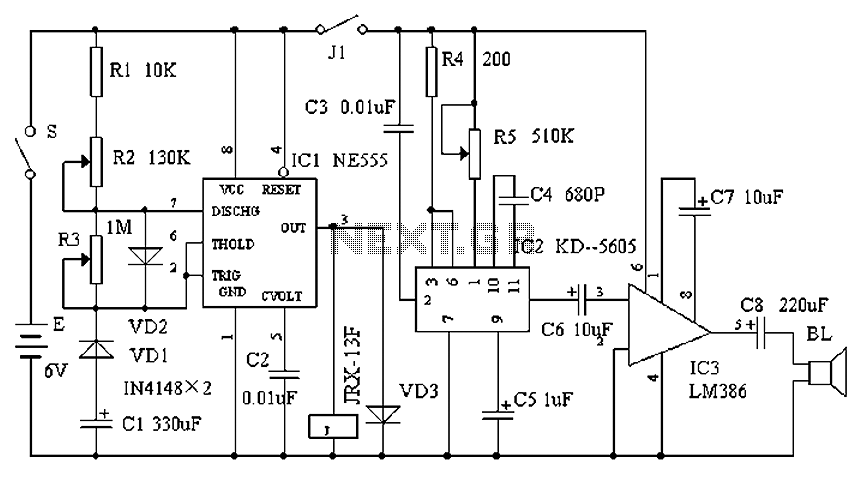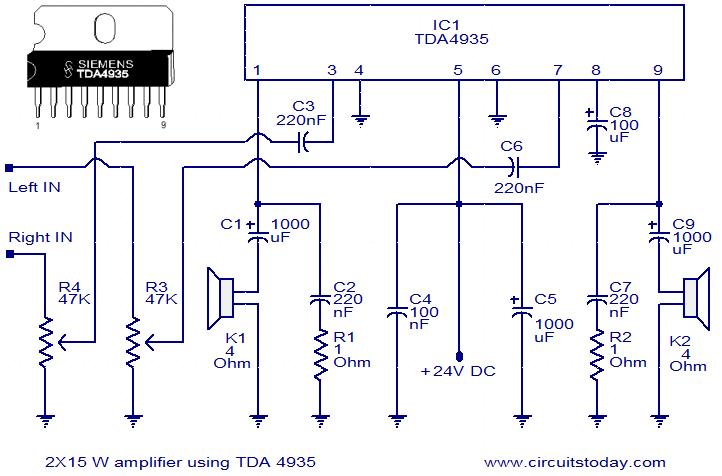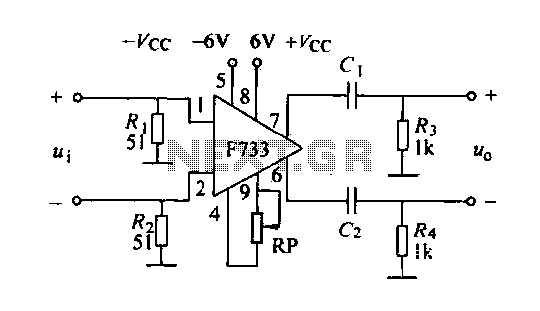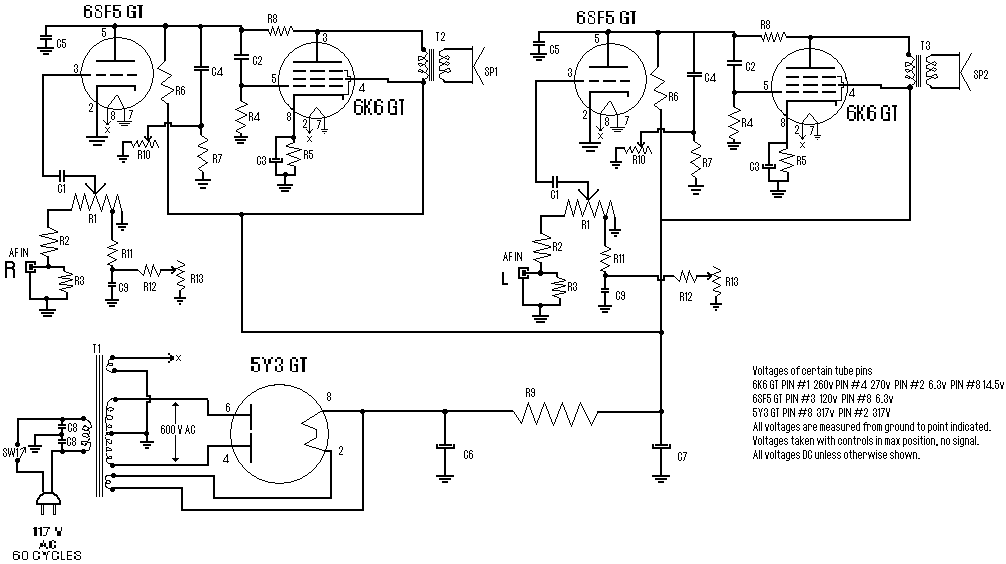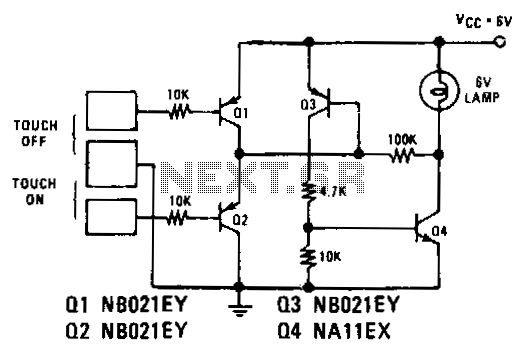
guitar amplifier electronic 60 watt
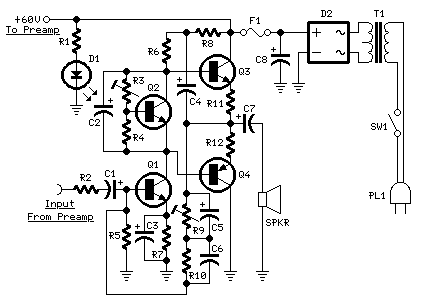
This guitar amplifier electronic architecture utilizes a robust conventional circuit design for the power amplifier, employing a single-rail supply of approximately 60V and capacitor coupling for the speakers. The advantages of this configuration for a guitar amplifier include a straightforward circuit, even for relatively high power outputs, and a certain degree of loudspeaker protection due to capacitor C8, which prevents voltage buildup from reaching the loudspeakers in the event of a failure of the output transistors. The preamplifier is powered by the same 60V supply as the power amplifier, allowing for a two-transistor gain block capable of delivering around 20V RMS output. This setup provides a very high input impedance capability. The Darlington transistor types suggested may be too large for this design, and alternatives such as MJ11014 (Q3) and MJ11013 (Q4) or TIP142 (Q3) and TIP147 (Q4) can be utilized. D1 and D2 can be any Schottky-barrier diode types; however, using common 1N4148 silicon diodes for D1 and D2 will yield a softer harmonic modulation operation. In all instances where Darlington transistors are employed as output devices, it is crucial that the sensing transistor (Q2) is in close thermal contact with the output transistors. Therefore, a TO126-case transistor type was selected for easy mounting on the heatsink, positioned very close to the output pair. Resistor R9 must be adjusted to measure approximately half the voltage supply from the positive lead of C7 to ground. A more precise setting can be achieved using an oscilloscope to ensure symmetrical clipping of the output waveform at maximum output power.
The described guitar amplifier circuit is designed with a focus on simplicity and performance, making it suitable for various guitar amplification applications. The use of a single-rail power supply simplifies the design and reduces component count, which can lead to increased reliability and lower production costs. The capacitor coupling technique ensures that the DC component does not reach the speakers, protecting them from potential damage due to DC offsets.
The preamplifier section, utilizing a two-transistor gain block, is crucial for achieving the desired signal amplification while maintaining high input impedance. This feature is particularly important for preserving the integrity of the guitar signal, allowing for a more dynamic and responsive performance. The choice of transistors in this section directly influences the amplifier's gain characteristics and overall sound quality.
The output stage employs Darlington transistors, which are known for their high current gain. However, careful consideration must be given to the selection of these transistors to ensure they fit the design specifications without compromising the amplifier's size or thermal management. The inclusion of a sensing transistor (Q2) in close thermal contact with the output transistors is essential for effective thermal regulation, ensuring that the amplifier operates safely and efficiently under varying load conditions.
The harmonic modulation aspect of the amplifier is also significant, as it contributes to the tonal characteristics of the output signal. The choice of diodes for this purpose can greatly influence the harmonic content and overall sound. The recommendation to use 1N4148 diodes for a softer harmonic modulation reflects an understanding of the desired tonal qualities that guitarists often seek.
Finally, the adjustment of resistor R9 for voltage measurement is a critical step in the calibration process. This adjustment ensures that the output waveform remains symmetrical, which is vital for achieving optimal sound quality and preventing distortion at high output levels. Utilizing an oscilloscope for this adjustment allows for precise tuning, enhancing the amplifier's performance in real-world applications. Overall, this amplifier design combines simplicity with effective sound shaping capabilities, making it a valuable tool for guitarists.This Guitar Amplifier electronic architecture adopts a able-bodied accustomed ambit cartography for the ability amplifier, application a single-rail accumulation of about 60V and capacitor-coupling for the speaker(s). The advantages for a guitar amplifier are the actual simple circuitry, alike for analogously aerial ability outputs, and a assertiv
e congenital amount of loudspeaker protection, due to capacitor C8, preventing the voltage accumulation to be conveyed into loudspeakers in case of achievement transistors` failure. The preamp is powered by the aforementioned 60V balustrade as the ability amplifier, acceptance to apparatus a two-transistors gain-block able of carrying about 20V RMS output.
This provides a actual aerial ascribe afflict capability. * The Darlington transistor types listed could be too oversized for such a design. You can substitute them with MJ11014 (Q3) and MJ11013 (Q4) or TIP142 (Q3) and TIP147 (Q4). * D1 and D2 can be any Schottky-barrier diode types. With these devices, the harmonic modifier operation will be hard. Using for D1 and D2 two common 1N4148 silicon diodes, the harmonic modifier operation will be softer. * In all cases where Darlington transistors are used as the output devices it is essential that the sensing transistor (Q2) should be in as close thermal contact with the output transistors as possible.
Therefore a TO126-case transistor type was chosen for easy bolting on the heatsink, very close to the output pair. * R9 must be trimmed in order to measure about half the voltage supply from the positive lead of C7 and ground.
A better setting can be done using an oscilloscope, in order to obtain a symmetrical clipping of the output waveform at maximum output power. 🔗 External reference
The described guitar amplifier circuit is designed with a focus on simplicity and performance, making it suitable for various guitar amplification applications. The use of a single-rail power supply simplifies the design and reduces component count, which can lead to increased reliability and lower production costs. The capacitor coupling technique ensures that the DC component does not reach the speakers, protecting them from potential damage due to DC offsets.
The preamplifier section, utilizing a two-transistor gain block, is crucial for achieving the desired signal amplification while maintaining high input impedance. This feature is particularly important for preserving the integrity of the guitar signal, allowing for a more dynamic and responsive performance. The choice of transistors in this section directly influences the amplifier's gain characteristics and overall sound quality.
The output stage employs Darlington transistors, which are known for their high current gain. However, careful consideration must be given to the selection of these transistors to ensure they fit the design specifications without compromising the amplifier's size or thermal management. The inclusion of a sensing transistor (Q2) in close thermal contact with the output transistors is essential for effective thermal regulation, ensuring that the amplifier operates safely and efficiently under varying load conditions.
The harmonic modulation aspect of the amplifier is also significant, as it contributes to the tonal characteristics of the output signal. The choice of diodes for this purpose can greatly influence the harmonic content and overall sound. The recommendation to use 1N4148 diodes for a softer harmonic modulation reflects an understanding of the desired tonal qualities that guitarists often seek.
Finally, the adjustment of resistor R9 for voltage measurement is a critical step in the calibration process. This adjustment ensures that the output waveform remains symmetrical, which is vital for achieving optimal sound quality and preventing distortion at high output levels. Utilizing an oscilloscope for this adjustment allows for precise tuning, enhancing the amplifier's performance in real-world applications. Overall, this amplifier design combines simplicity with effective sound shaping capabilities, making it a valuable tool for guitarists.This Guitar Amplifier electronic architecture adopts a able-bodied accustomed ambit cartography for the ability amplifier, application a single-rail accumulation of about 60V and capacitor-coupling for the speaker(s). The advantages for a guitar amplifier are the actual simple circuitry, alike for analogously aerial ability outputs, and a assertiv
e congenital amount of loudspeaker protection, due to capacitor C8, preventing the voltage accumulation to be conveyed into loudspeakers in case of achievement transistors` failure. The preamp is powered by the aforementioned 60V balustrade as the ability amplifier, acceptance to apparatus a two-transistors gain-block able of carrying about 20V RMS output.
This provides a actual aerial ascribe afflict capability. * The Darlington transistor types listed could be too oversized for such a design. You can substitute them with MJ11014 (Q3) and MJ11013 (Q4) or TIP142 (Q3) and TIP147 (Q4). * D1 and D2 can be any Schottky-barrier diode types. With these devices, the harmonic modifier operation will be hard. Using for D1 and D2 two common 1N4148 silicon diodes, the harmonic modifier operation will be softer. * In all cases where Darlington transistors are used as the output devices it is essential that the sensing transistor (Q2) should be in as close thermal contact with the output transistors as possible.
Therefore a TO126-case transistor type was chosen for easy bolting on the heatsink, very close to the output pair. * R9 must be trimmed in order to measure about half the voltage supply from the positive lead of C7 and ground.
A better setting can be done using an oscilloscope, in order to obtain a symmetrical clipping of the output waveform at maximum output power. 🔗 External reference
